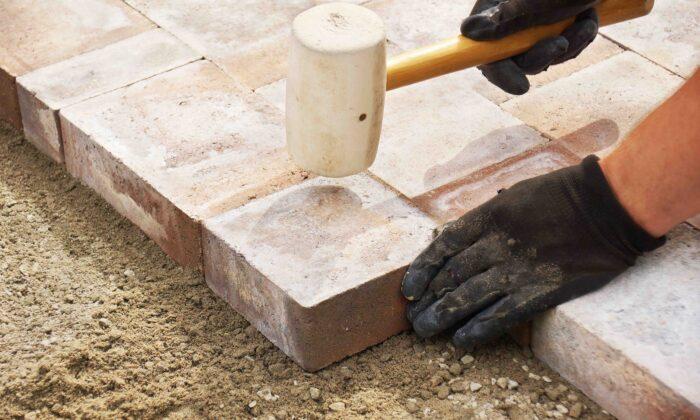Summer is here, and it’s time to do outdoor projects. A project that will have long-lasting benefits is installing a patio. Depending on the configuration of your backyard, you may have a choice between a deck and a patio. The installed price is often comparable depending on tractor access and the type of desired accessories, like seating arrangements, fire pits or water features. In the long run, the patio will require less maintenance. Installing a concrete stone patio is not technically difficult, but it is very labor intensive. Many people are attracted to concrete paving stones because they come in a variety of shapes, patterns and colors. They come in a range of colors similar to most house bricks and if installed with a blend of colors, they visually soften the appearance of large areas of paving.
Concrete paving stones differ from old-fashioned bricks in that they are solid concrete all the way through. Bricks are baked like a loaf of bread and are soft in the center where they can absorb water and break. Paving stones also must pass stiffer standards than regular concrete as set by the American Society of Testing Materials (ASTM). A regular concrete slab must pass a compression test of 3,500 pounds per square inch (PSI). The individual stones must pass 8,000 PSI. The ASTM test for maximum water absorption for concrete is 20% to 25% of its total weight. For paving stones, it is only 5%. If concrete absorbs more than 10%, the surface can flake off. Another benefit of paving stones is evident during freeze and thaw cycles in the winter. A concrete slab moves in an all-or-none fashion that causes cracks, while paving stones can relieve the tension in tiny, unseen and easy-to-replace increments.
Like any other construction project, a firm foundation is essential to having a superior finished product. Any drainage problems will need to be solved before installing any type of patio. For pedestrian traffic, a compacted gravel base of 4 to 6 inches is desired and for vehicular traffic, a 10- to 12-inch base is required. On top of the gravel will be a layer of loose sand 1 to 2 inches deep.
The paving stones themselves are about 2 inches thick, which adds up to about 9 to 14 inches of excavating. If it can be done with a tractor, it isn’t too much work. Hauling all that dirt, gravel, sand and stone by wheelbarrow can be a lot of work. Don’t forget to call utility companies to find out if any lines or pipes will be in the way.
The pattern of the stones and the shape of the patio will determine how many stones will need to be cut along the edges. This determines how much extra labor and how much waste there will be. A square pattern with straight edges is easy to install and has little waste, while a diagonal pattern with curved edges is very wasteful. As far as borders are concerned, in some cases, sod itself will work. A concrete curb can be used in some vehicular applications. For most uses, a flexible plastic edge specifically designed for this purpose, installed below the grade, remains invisible and works the best. After the stones are laid and any pieces cut and in place, dry sand is spread on the stones. All of the sand used must have sharp edges, not smooth edges like river-washed sand. The compactor that was used on the gravel base is now used to tamp the stones into the sand. As some sand is rising in the cracks, more sand is falling in, and with all of the sharp edges the stones and sand all lock into place.
If you are a handy person, you probably have all the tools except the compactor and masonry saw, which many rental firms carry. If you take some photos and measurements to your local garden center, they can help you determine the proper quantities of materials, and many of them have do-it-yourself instruction booklets.







Friends Read Free